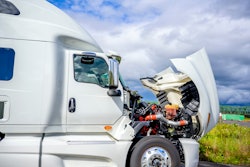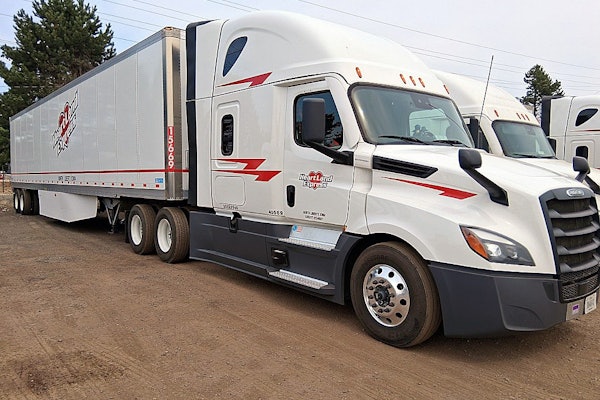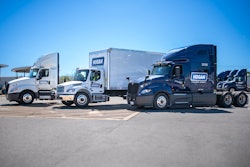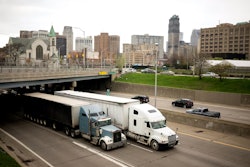Is a truck driver with a sleeper tractor working from home on the road? Or home officing? Perhaps a less divisive phrase for it is remote-officing.
What seems like the third rail of management maturity is the endless debate about whether home officing is good or bad. Some 60% of new semi-tractors sold are sleepers. It’s a twist on home officing where the home goes to work everyday with the driver.
NACFE estimates the percentage of over-the-road drivers — those that do not return to base each day — is about 10%. Most of those likely are driving sleeper units, although some may drive day cabs in combination with finding lodging on the road.
While on the road, I would submit these drivers are technically home officed and they have been for decades. I don’t recall in some 45 years ever seeing arguments about the inability to manage drivers because they don’t come into the home office building each morning.
Driving is a tough, physical and technical job requiring significant self-management. Some drivers may never even see the corporate building, doing what NACFE has termed disparate routes: going from Atlanta on Monday to San Francisco on Friday, then off to Minneapolis, and so on. Each day provides an entirely new destination.
I submit that somehow fleets manage these driver assets without the need to personally supervise them eyeball-to-eyeball. Yet somehow office managers can’t seem to manage professional staffs in many situations without physically being able to see them each day.
Smart people like CEOs heading major corporations have taken stands that their companies are at severe risk because of home officing. I readily admit there are jobs that require physical presence in a building. Truck makers could not build trucks without people in the factory each day. Hospitals conducting surgeries could not function without people under the same roof. Major test facilities with capital investment in special equipment, test tracks, wind tunnels, metallurgy, etc. require people on site to be of any value.
But I suggest there are a million jobs being done remotely today — like truck drivers, utility workers, pilots, loggers, delivery people, and literally anyone who works on a computer — where the office building is largely irrelevant to their function.
The bullpen
The COVID-19 pandemic was a great experiment in supervising people. It also highlighted that quality of life was as important as employment. Eliminating commutes, traffic, water cooler time, punch clocks, and other non-value added time wasters meant people were more able to juggle life and work. Progressive managers found they actually got more productivity out of many people on their staff. Studies done at corporate levels indicated home officing was actually improving KPIs.
Yet traditional bullpen management techniques from ancient times prevail. A bullpen, for those who never had the joy of working in one, was where the office manager (“boss”) sat at one end of a large room, and all the staff sat at desks uniformly packed together filling the room. No walls, no privacy, no individualism. Office workers enjoying this environment also had strict dress codes – skirts for women and men had to wear white shirts and ties. Supervisors were trained that if a worker’s head was down, they were working, and conversely if they could see their faces, they were not working.
It didn’t matter if the office was equipped with typewriters, drafting boards, adding machines, ledgers, telephones, or whatever else. The bullpen had an overseer cracking the whip over the workers. That was the accepted work environment.
The growth of corporations introduced vertically and horizontally structured organizations that inherently distributed work in different regions and time zones, and even different countries. The office day might see a worker talking by phone with people all over the world to manage projects and get work done. Yet their local supervisor had to keep eyeballs on them to make sure they were at their desk.
The Apollo space program and huge efforts like submarines and commercial jet aircraft created multi-corporation programs with interrelated elements working all over the world. Yet supervisors in offices still felt the need to ride herd on their staffs. Everyone had to show up on time, stay the required hours, and go home at the same time, leading to the growth of a phenomenon oddly named rush hour. (Who has ever rushed in rush hour traffic?)
Major companies made massive capital investments in brick and mortar buildings, skyscrapers in many cases such as the Pan Am building in New York City, the Sears Tower in Chicago, the Hancock building in Boston, and more. All those building brought with them demanding cash flow needs to cover maintenance, energy for lights and heating and cooling systems, security people, cleaning services, insurance, taxes, office equipment, information technology infrastructure, etc. The cost of doing business.
Mergers and acquisitions frequently found opportunities to shave costs by consolidating groups, locations and functions to reduce these expenses.
Through it all, supervisors — that necessary mid-level overhead to manage staff — were given the role of keeping their eyes on the workers to make sure they did their work.
The big change
COVID-19 and the subsequent lockdown demonstrated that mid-level management and even high-level management might be overstaffed. Perhaps many of the traditional day-to-day functions of supervisors were not being efficiently executed, and perhaps workers might be more efficient with less oversight. Certainly, operating costs to maintain buildings could drop significantly, passing that buck to the home-offices. During COVID, some major office buildings looked like old west ghost towns or a scene from the Omega Man movie. All that was missing were tumbleweeds blowing down aisles of offices.
Somehow companies continued to do business, work was done, profits were made. Yes, not everywhere, but many did. That period accelerated the use of smart phones to manage things on the fly, place purchase orders, hold meetings, get deliveries of products, even getting food delivered to homes. E-commerce thrived during COVID. It accelerated the reduction of commercial stores and malls.
Defense and R&D organizations often have situations where your supervisor is not cleared to know what you are working on. In some commercial organizations, often your supervisor has changed so frequently that the current one likely doesn’t really know what you do. In both situations, counting that your butt is in a seat and your head down is as much management as they provide.
The freight industry has need for staffing back-offices. There are some activities where small staffs are particularly effective because they physically sit close to each other. There are situations with training new hires where osmosis of knowledge and skills can only be done through proximity.
But if you work at a desk driving a computer, you have the world at your fingertips — physical location is irrelevant. Time zones are largely irrelevant. I know an engineer for a computer manufacturer that worked out of his home in Maui, interfacing with people in the mainland, Europe and Asia on a daily basis to develop products. His office straddled the world, but his body was in Maui. His commute was the distance from his kitchen to his desk, 20 feet. Zero time wasted on non-value added activities like traffic, parking, traffic accidents, flat tires, construction zones, etc. The flexibility his company provided, pre-COVID, allowed him on one day to attend a meeting in Holland at 1 a.m. local time, then attend a meeting in Seoul at 1 p.m. the next day. Such is the reality of modern global business. Work can go on 24 hours a day.
Years ago, researchers at Cambridge in Britain measured the likelihood that a person sitting at a desk would consult with someone a few feet away. The productivity myth of the closely spaced desks is that it should improve project cohesiveness and awareness of what others are doing. The data was disappointing. The likelihood of interfacing visually and verbally with someone drops off dramatically at just a few feet. We are now more likely to email someone than call them, even if we can see the back of their head a few desks away. Those working with people in other sites would require expensive time and travel for face-to-face interactions. Most of the time, day-to-day interactions between these people occurs via electronic messaging or computer conference calls. Those in different time zones working on the Pacific Coast often send work to those on the East Coast after the East Coaster have gone home, expecting them to get to their messages the next morning. An 8-hour work shift for contiguous U.S. workers is really 11 hours through the miracle of computer communications, with no overtime or travel costs.
The gig economy has made many workers into commodities, hired and let go as needed. Gone are the days where companies hired people nearly for life. How many new hires today will stay in a company more than a few years? Those 30-, 40-, or -50-year retirement parties are becoming less and less frequent than in the 1960s and 1970s. Workers, for a variety of reasons both their own and their companies, just don’t stay at any one company that long.
That has impacted corporate knowledge tremendously. The lack of corporate history by workers begs the question: What is the benefit of being co-mingled in an office? Many organizations now outsource expertise as they have eliminated their internal talent pool. Workers often don’t even know or care about the physical location of their help centers.
The war between in-office and remote-officing forces will continue. I think the cat (or more exactly, the alligator) was let out of the bag during COVID. I think over-the-road truck drivers are the epitome of remote-officed people and an example to emulate. They are trusted to do their jobs, they rarely if ever have a supervisor physically nearby, and they are efficient and effective at creating profits for the company. Supervisors should expect all those are attributes from any worker.
Why is remote-officing so hard for traditional management types to benefit from? Change can be tough. A Ronald Reagan quote might help. “Trust but verify.” Figure it out. That’s what managers are supposedly getting paid for.













